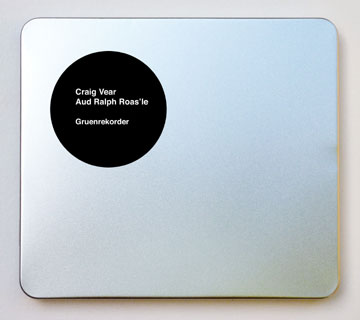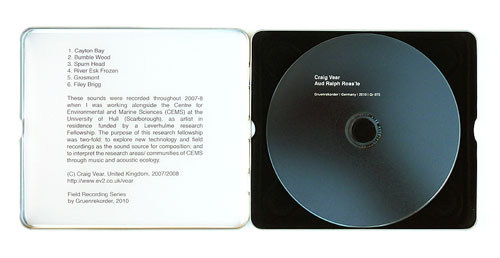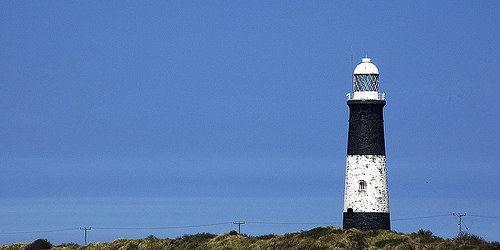
Aud Ralph Roas’le | Craig Vear
North Yorkshire Coast
Gr 075 | Gruen CD-R | Silver > [Sold Out]
MP3 & FLAC > [order]
Blue skies, on-shore wind, massive breakers … waves crashing on the Brigg, the energy transferring through the rock into the pool … dense woodland; dead and fallen trees were propped up against their living neighbours … shrimp, Goby, unknown ‘grazers’ … crackle: a constellation of different species feeding, communicating, living amongst this huge pool … a myriad of little sounds as one continuous line … the tide flowed, it looked as if a giant brown, mechanical Archimedes screw was clawing it way up the beech devouring everything in its path … distorted and bent … the captured voices of tiny moments in the ecology of a vast coast and moorland.
Aud Ralph Roas’le captures the energy and experience of these voices found in the North Yorkshire Moors. I experimented with different and unusual microphone configurations to capture more than the aural, and to evoke a mental state of ‘see-hearing’ where the sound evokes a sense of place; of aural landscape.
These sounds were recorded throughout 2007-8 when I was working alongside the Centre for Environmental and Marine Sciences (CEMS) at the University of Hull (Scarborough), as artist in residence funded by a Leverhulme research Fellowship. The purpose of this research fellowship was two-fold: to explore new technology and field recordings as the sound source for composition; and to interpret the research areas/ communities of CEMS through music and acoustic ecology.
1. Cayton Bay
2. Bumble Wood
3. Spurn Head
4. River Esk Frozen
5. Grosmont
6. Filey Brigg
6 Tracks (44′45″)
CD-R (50 copies)
Recorded on location in and around the North Yorkshire Moors National Park and coastline. With thanks to Magnus Johnson, Ambrose Field, Leverhulme Trust.
www.ev2.co.uk/vear/leverhulme.html
Photo „Spurn lighthouse“ by Mac Jordan
Field Recording Series by Gruenrekorder
Gruenrekorder / Germany / 2010 / Gr 075 / LC 09488
Ed Pinsent | The Sound Projector
Craig Vear is an English field-recordist. He made Aud Ralph Roas’le (GRUENREKORDER Gr 075) while an artist in residence at the University of Hull, and his purpose was partially to test new recording equipment for the Centre for Environmental and Marine Sciences. Woods, rivers and the seashore are those triumphs of nature’s marvel that command most attention from Vear’s mics, but the impressive weather systems also make unforgettable appearances on the record. Come to that the whole CD feels like it’s drenched in bracing English rain and wind. Considering he’s realised a lot of projects in Antarctica, perhaps Vear finds his inner compass is irresistibly drawn towards inhospitable climes. Certainly the tracks here which feature ice (such as ‘River Esk Frozen’) create some of the more memorable listening moments.
Brian Olewnick | Just outside
A set of six field recordings, I guessing layered in from various locations though I’ve been wrong often enough about that before. They seem to be pure sounds, often aqueous in nature, with various manifestations of water churning against piers or boats or rocks or what-have-you. One often hears undercurrents of engines, low thrums that reverberate below the liquid, implying the earthen basin in which it lies. There’s one violent track where, it appears, a massive storm erupts, overwhelming the recording equipment to a degree where distortion sets in. All of the pieces are crammed full, actually, somewhat agitative. In the end, though, they strike me as just thick, full field recordings. Not bad, but not commanding my attention or eliciting much fascination.
Ron Schepper | textura
Aud Ralph Roas’le captures sounds recorded at the North Yorkshire Moors National Park and coastline throughout 2007-8 when Vear was working alongside the Centre for Environmental and Marine Sciences (CEMS) at the University of Hull as an artist-in-residence and engenders a powerfully evocative sense of place through its up-close renderings of aural landscapes. In many of the pieces, identifiable natural elements—the crash of waves, creak of a boat, chirp of birds, dribble of water—help transport the listener into a specific geographical setting with relative ease. “Cayton Bay,” for instance, suggests the controlled roar generated by a waterfall or perhaps a river recorded with an extremely up-close microphone. Regardless, the piece unspools as an even-keeled mass of constantly combustible sound, in marked contrast to the setting that follows, “Bumble Wood,” where immense peaks are scaled and the intensity levels shift in extreme manner. Amidst the dominating roar of water, birds caw and squawk in “Grosmont” while a plane travels overhead and a motor engine revs. In other cases, the originating elements possess a more abstract quality, and the piece in question assumes the character of an electronically generated soundscape. Two such examples are “Filey Brigg,” which presents a stream of cricket-like click, crackle, and hiss, and especially “Spurn Head,” where tension builds to immense proportions as one braces oneself for the next Merzbow-like blast that will decimate the track’s gravelly surface.
Frans de Waard | VITAL WEEKLY
But there is also field recordings, as represented by Craig Vear, of whom I never heard, who worked for the Centre for Environmental and Marine Sciences in Hull. The purpose of his fellowship was twofold „to explore new technology and field recordings as the sound source for composition; and to interpret the research areas/communities of CEMS through music and acoustic ecology“. Six pieces of these aquatic recordings, and although the website of Gruenrekorder says Vear works with computer technology, I think that these six pieces simply work with pure and untreated sounds from nature. Washes of sound and wind, blowing straight into the microphone, but they are quite different pieces. ‚Spurn Head‘ is almost like a noise piece – that loud – but ‚River Esk Frozen‘ is, on the hand, a water piece and some branches near the shore. A plane comes over in ‚Filey Brigg‘ and bird calls in ‚Grosmont‘. Cut from reality, but presented as a composition and I must say this works quite well.

